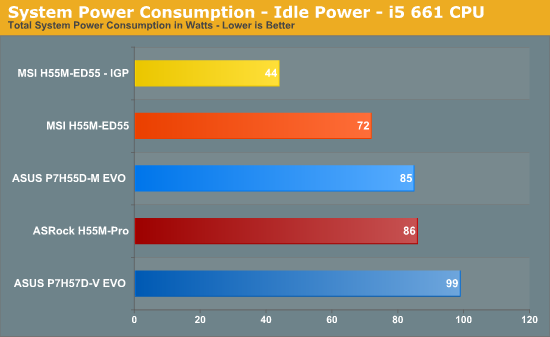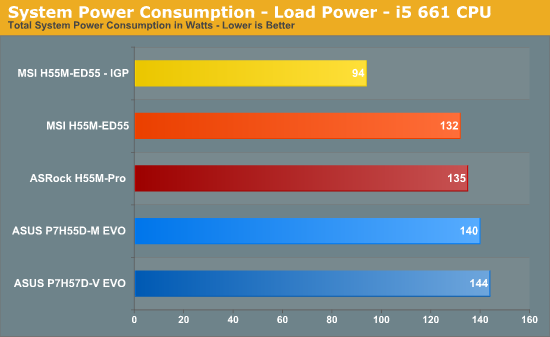Choosing the Best H55/H57 Motherboard - Part 1
by Rajinder Gill on January 31, 2010 11:30 PM EST- Posted in
- Motherboards
Testbed Setup and Power
| Testbed Setup - Overclocking / Benchmark | |
| Processor | Intel Core i5 661 ES CPU - 3.33GHz - 2 Cores 4 Threads, 4MB Cache |
| CPU Voltage | Various |
| Cooling | Intel air cooler Heatkiller 3.0 waterblock PA120.2 radiator and DDC ultra pump (with Petra top) 1/2 ID tubing for watercooling |
| Power Supply | Corsair HX950 |
| Memory | Corsair Dominator CMD8GX3M4A1600C8 1600MHz 8GB kit G.Skill Perfect Storm 8-8-8-24 2200MHz 4GB kit Corsair Dominator GT 8-8-8-24 2200MHz 4GB kit (X2 for 8GB) |
| Memory Settings | Various |
| Video Cards | MSI 275 Lightning (stock clocks) |
| Video Drivers | nVidia 195.62 WHQL |
| Hard Drive | Western Digital 7200RPM 1TB SATA 3/Gbps 32MB Buffer OCZ Vertex 120GB SSD |
| Optical Drives | Plextor PX-B900A Toshiba SD-H802A |
| Case | Open Test Bed - Dimastech Benching Station Lian-Li V2110 |
| Operating System | Windows 7 64 bit |
| . | |
We utilized memory kits from Corsair and G.Skill to verify memory compatibility on our test boards. Our OS and primary applications are loaded on the OCZ Vertex 120GB SSD drive and our games operate off the WD Caviar Black 1TB drive. We did a clean install of the OS and applications for each motherboard.
We used Intel's stock cooler for the stock comparison testing, while water-cooling via the superlative Heat Killer 3.0 water block was utilized for overclocking. For graphics duty, we used MSI's GTX 275 Lighting GPU to provide performance comparisons between boards during gaming benchmarks.
For our test results we set up each board as closely as possible in regards to memory timings. Otherwise all other settings are left on auto. The P55 utilized 8GB of DDR3 (apart from DFI's MI-T36 which is limited to 4GB), while the X58 platform contained 6GB. The P55 and X58 DDR3 timings were set to 7-7-7-20 1T at DDR3-1600 for the i7-920 and i7-870 processors at both stock and overclocked CPU settings.
We used DDR3-1333 6-6-6-18 1T timings for the i5-750 stock setup for all system benchmarks (non-gaming tests) as DDR3-1600 is not natively supported at a stock BCLK setting of 133.
For our Clarkdale i5 661 CPU, we used 7-7-7-20 1N timings at DDR3-1333MHz with 8GB of memory. We would have preferred to use CAS 6 timings to match our Lynnfield setup, but it seems 8GB of memory at CAS 6 on Clarkdale is not possible right now. The 4GHz gaming results used 8GB of memory at DDR3-1200 with CAS 6-6-6-18 1N timings to allow a BCLK of 200MHz with the QPI ratio in sync with CPU frequency.
There's little to separate these boards when you run them at a fixed frequency, showing nothing more than a 1-2% swing in most instances, which goes completely unnoticed in real world usage.
Power consumption
Our power consumption testing utilizes the same batch of components under similar circumstances in a bid to monitor variances between idle and CPU load conditions using an AC wall meter for power consumption measurements. We install the vendor supplied power saving utilitites on each board and enable power saving modes that don't involve any kind of underclocking or CPU core frequency modulation in order to run an apples to apples comparison.
Assuming a maximum 150w load in the worst case scenario, actual motherboard power consumption is around 15%~17% lower than the shown figures if you factor out switching losses at the PSU.


MSI continues in its dominance of idle/light load power saving performance by using buck controllers that support low switching speeds and allow phases to be turned off in light load conditions.
A graphics card like nVidia's 275 will add around 28w of idle power consumption to a Clarkdale system. It is unfortunate that Intel (and board vendors) do not offer drivers/GPU power management that allow a discrete GPU to be powered on/off on demand - the power savings would be rather attractive.
Note that most of the CPU VCC power saving features on these boards need to be turned off when overclocking to ensure system stability and to prevent PWM burnouts under modulating loads at higher levels of current draw. With power saving features switched off, you get a 5~10W increase in the idle power consumption at the same operating frequency, while load power consumption remains roughly the same due to current loading.










56 Comments
View All Comments
Rajinder Gill - Monday, February 1, 2010 - link
Hi Rick,I have not heard of or seen anything that offers 10 onboard SATA ports on H55 yet. If I hear of anything, I'll let you know.
regards
Raja
Rick83 - Monday, February 1, 2010 - link
Many thanks :-)marc1000 - Monday, February 1, 2010 - link
Bottom line: DON'T BUY anything from Intel this generation. If you are not an advanced user who knows exactly what you are doing, then it is best to skip completely the current products.I'm saying this because there is a great chance you will pay more for something that offer less, or will get a crappy product, or will buy something believing it was "awesome" only to latter find it was actually "mediocre".
This is because the RIDICULOUS naming scheme Intel has chosen to use in the current CPU+Chipset.
Like some other user pointed here already: there is not ONE way to know if you are buing a dual or quad-core CPU simply by looking at it's name. You MUST know the exact specification based on model number (that does not mean nothing more than an obscure performance indicator).
And the trend seems to continue with the chipsets... you get a chipset that is more expensive and with less resources but the name makes it "look" like it is better!
HobHayward - Monday, February 1, 2010 - link
Unless I'm mistaken your description of the instant boot utility is misleading. At least on my ASRock x58 extreme, the instant boot function overrides the standard shut own procedure, and instead causes the system to restart, boot all the way back into windows, and then put the system into sleep mode. This way you have a fresh boot when you return to your computer, without having to wait for a full boot.Rajinder Gill - Monday, February 1, 2010 - link
Sorry, you are correct, I've added some text. The latter feature is akin to hibernate (suspend to disc) for fast boot.michal1980 - Monday, February 1, 2010 - link
I'm waiting for an editorial. The fact that you had to wait for multiple bios revisions for a STABLE build, is imho unaccetable.I almost bought one of these boards, and then remebered my rule, wait at least 6 months. Because mobo makers release CRAP. And no one in the industry seems to call them on it. People that work for anandtech have an insider edge for support, end users get fu*ked with shitty parts.
Is it really that hard to launch with a stable OS? If the end user is to be a fu*king beta tester, then I want free boards.
YellowWing - Monday, February 1, 2010 - link
I am interested in seeing more power figures for these boards with only the IGP. One of the unknowns in building a small HTPC with these boards is sizing the power supply. Many of the smaller cases come with small wattage power supplies.Power figures for each board with only the IGP will help size the minimum supply needed for these boards.
I would also like to see the figures for the i3-530, which may be the most popular CPU for a HTPC build on Clarksdale
Bloodx - Tuesday, February 2, 2010 - link
1080P/24 does not work correct. Until Intel releases a driver that corrects there is no point using this for an HTPC.piasabird - Monday, February 1, 2010 - link
So why not just use an E7500 and an integrated MATX motherboard?I have not seen any real comparison between that and an I3 entry level processor. My guess is besides HDMI there is not much difference. One advantage is with an older chipset you have more stability.
hyvonen - Monday, February 1, 2010 - link
Why i3/i5 + H55/H57?1) Higher performance (both CPU and IGP).
2) Lower power consumption at load.
3) DTS-MA/Dolby TrueHD Bitstream support through HDMI.
4) Dual hardware HD decoding.